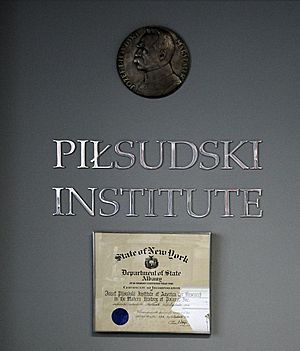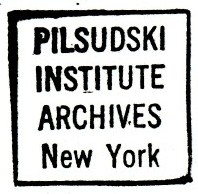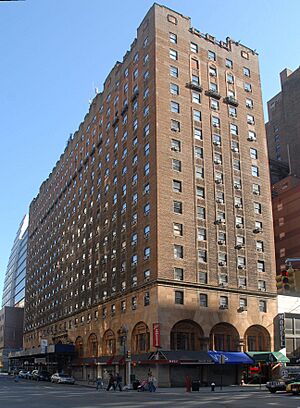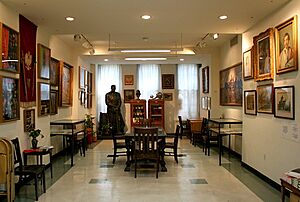Józef Piłsudski Institute of America facts for kids
The Józef Piłsudski Institute of America is a museum and research center in Greenpoint, Brooklyn, New York. It is dedicated to studying the modern history of Poland. The institute is named after Józef Piłsudski, an important Polish leader from the time between World War I and World War II.
Contents
History of the Institute
Why the Institute Was Created
The Piłsudski Institute of America was created on July 4, 1943, during World War II. A group of Polish leaders who were living in the United States met in New York City. They wanted to create a place to protect Poland's history.
Some of the founders had worked with the famous Polish leader Józef Piłsudski. They knew it was important to save documents about Poland's history, especially during the war. The institute was inspired by a similar one that had existed in Warsaw, Poland, before the war.
A Dangerous Time for Poland
The institute was founded at a very difficult time. In 1943, Poland was occupied by Nazi Germany. The Nazis were trying to destroy Polish culture. They closed universities, libraries, and museums. They also arrested and killed many professors and educated people.
At the same time, the Soviet Union was also a threat to Poland. The relationship between the Polish government-in-exile (Poland's government that was working from outside the country) and the Soviet Union had broken down. The founders of the institute worried that Poland's history and culture would be lost forever.
They decided to act. By creating the institute in America, they could safely collect and protect important historical documents. Their main goal was to gather materials that could one day help rebuild the collections in Poland that had been destroyed.
Getting Started
The institute started small. It was first located at 105 East 22nd Street in Manhattan. At its first meeting, Wacław Jędrzejewicz became the director. The founders traveled to cities with large Polish communities, like Detroit and Chicago, to find members and support.
They explained their mission: to collect and save documents about Poland's recent history. Soon, people began to donate valuable books and papers related to World War II and the activities of Poles around the world.
After World War II
After the war ended in 1945, Poland came under the control of the Soviet Union. This meant the institute's original plan to send everything back to Warsaw wasn't possible. So, the founders decided to make the institute in New York a permanent, independent organization.
Its new mission was to continue collecting documents and to teach people the true story of Poland's history. For many years, the institute was a key center for Poles who believed in an independent Poland, free from foreign control. It survived because of the hard work and donations of its members and leaders.
The Institute Today
After Poland became a free country again in 1989, the Piłsudski Institute of America could finally work with institutions in Poland. It began to cooperate with the National Library in Warsaw, universities, and other research centers.
Today, the institute is an important place for anyone studying Polish history. It welcomes researchers from all over the world, including the United States, Poland, Japan, and many other countries.
What's Inside the Institute?
The institute has a huge collection of historical materials. It is one of the largest collections of documents on modern Polish history outside of Poland.
Archives and Documents
The archives contain over one million pages of documents. These include:
- Papers from Polish leaders and diplomats, like Kazimierz Sosnkowski.
- Records from Polish organizations during World War II.
- Documents about the lives of Poles who lived in different parts of the world.
- Materials that were smuggled out of Poland in 1939 to keep them safe.
Library and Other Collections
- Library: The library has about 23,000 books on Polish history and culture.
- Audio-Visual Collection: This includes recordings of people sharing their memories, such as surviving Soviet labor camps.
- Art Collection: The institute has about 240 paintings and drawings by famous Polish artists like Jan Matejko and Jacek Malczewski.
- Other Items: There are also thousands of photographs, maps, stamps, and medals. One special medal celebrates the Battle of Somosierra from 1808.
Leaders of the Institute
The institute has been led by many dedicated people over the years. Here are some of the presidents and executive directors who have guided its mission.
Presidents
- 1943–1944: Franciszek Januszewski
- 1944–1951: Stefan Łodzieski
- 1951–1953: Franciszek Januszewski
- 1954–1955: Ignacy Nurkiewicz
- 1955–1961: Henryk Korab-Janiewicz
- 1961–1962: Władysław Bortnowski
- 1962–1969: Henryk Korab-Janiewicz
- 1969–1972: Wiesław Domaniewski
- 1972–1977: Jan Fryling
- 1977–1978: Wacław Jędrzejewicz
- 1978–1983: Tadeusz Pawłowicz
- 1983–1993: Stanisław Jordanowski
- 1993–1999: Andrzej Beck
- 1999–2008: Jacek Gałązka
- 2008–2016: Magdalena Kapuścińska
- 2016–present: Iwona Korga
Executive Directors
- 1943–1948: Wacław Jędrzejewicz
- 1949–1951: Marian Chodacki
- 1951–1956: Damian Stanisław Wandycz
- 1956–1963: Wincenty Kowalski
- 1963–1964: Wacław Jędrzejewicz
- 1964–1972: Jan Fryling
- 1973–1983: Michał Budny
- 1989–1991: Jerzy Prus
- 1992–2000: Janusz Cisek
- 2005–present: Iwona Korga
See also
- Józef Piłsudski Institute in London
- Polish Institute and Sikorski Museum






